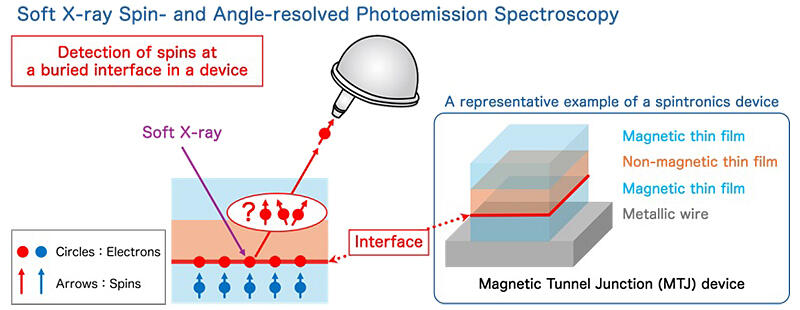For developing ultrafast, ultralow-power-consuming spintronic devices, the electron-spin behavior inside device materials is important. However, conventional measurement methods require approximately one week for evaluation. Project Leader Hideaki Iwasawa and Principal Researcher Tetsuro Ueno of the Synchrotron Radiation Research Center of the Kansai Institute for Photon Science at the National Institutes for Quantum Science and Technology (QST), in collaboration with Associate Professor Kenta Kuroda of the Graduate School of Advanced Science and Engineering at Hiroshima University, and Professor Taichi Okuda of the Research Institute for Synchrotron Radiation Science at the same university developed a method that measures electron spin in less than one-tenth of the time required by conventional methods. A measurement system utilizing this method will be installed at NanoTerasu in the summer of 2025 and made available on shared beamlines. The results were published in Scientific Reports.

Provided by QST
Spintronics allows for the realization of computing and memory functions using spin states inside device materials, meaning that measuring these states is useful for development. To date, the research group has developed an instrument that measures spin states using soft X-ray spin- and angle-resolved photoemission spectroscopy (SARPES), a state-of-the-art measurement technique. However, because the measurement results are obtained by repeating measurements 600 times and accumulating the results, it takes about one week to measure one device, during which time samples deteriorate and measurement accuracy decreases. Therefore, this measurement process has not yet been employed in practical applications.
The introduction of a new AI technology to the measurement process has enabled short measurement durations and the extraction of accurate information, even from noisy data. The research group thereby succeeded in reducing the measurement time to one-tenth of the time previously possible, enabling the method's practical application. Specifically, a machine learning method called Gaussian process regression (GPR) is used to produce a noise-free spectrum for each time data (measurement spectrum) acquired in each measurement process. In turn, the degree of agreement (GPR score) with the actual measurement spectrum is evaluated. The GPR score is an indicator of the certainty of the data. This has made it possible, for the first time, to "quantitatively determine data quality," which has been difficult in the past.
In a demonstration experiment using a topological insulator, the degree of agreement reached 95% (GPR score 0.95) after 57 measurements, and spin polarization was determined with the same accuracy as before. This enables measurements within a day with sufficient accuracy.
Iwasawa stated, "I believe that the availability of this technology at NanoTerasu will greatly advance the development of next-generation information devices as it can be applied not only to spintronics materials but also to quantum materials in general, such as solid-state batteries and power semiconductors."
Journal Information
Publication: Scientific Reports
Title: Efficiency improvement of spin-resolved ARPES experiments using Gaussian process regression
DOI: 10.1038/s41598-024-66704-8
This article has been translated by JST with permission from The Science News Ltd. (https://sci-news.co.jp/). Unauthorized reproduction of the article and photographs is prohibited.




